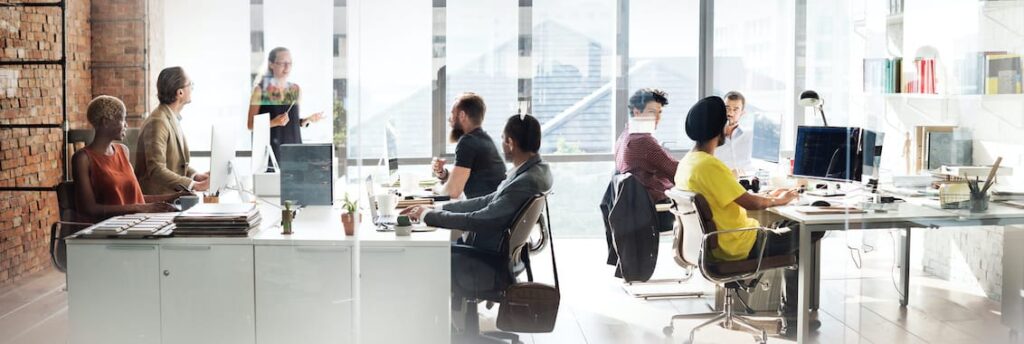The CoViD pandemic has fundamentally changed the way we work. The combination of movement and contact restrictions, modern communication infrastructure, and collaborative technologies has made remote working an increasingly viable option. In this new context of hybrid work, it is necessary to re-examine best practices for workplaces. How does a business go about creating best-in-class office space?
Investments in workplace transformation are a priority for most businesses even amid the upheaval of the pandemic. An increasing number of companies are eyeing a change to flexible hub-and-spoke workplace models. How employees react to these changes may well depend on their age, with surveys suggesting younger employees are more open to flexible working. The aspect of employee experience is important, because an estimated 41% of employees are considering changing jobs. All this means creating efficient, flexible, and ergonomic workplaces is more important than ever.
A study by the International Data Corporation (IDC) has attempted to define best practices and building blocks for a modern workplace. In collaboration with high-profile space providers and businesses, the study examines the issue with an envisioned end-state of best employee experience, ease of marketing, high flexibility and measurability, future-proof infrastructure, and security. How might such an office be built?
Consistent experiences
In a time of upheaval and uncertainty, the foremost building block is consistency in employee experience. It is well acknowledged that consistency in HR policies helps with employee hiring and retention. The same applies for consistency in workplace experience. Predictable and repeated office habits and interactions can greatly smooth the ongoing workplace transition to hybrid work.
A best-in-class workplace should ensure consistent work tools, ambience (such as lighting and HVAC), personalisation, and services (such as security and parking) across the business real estate. With hub-and-spoke office models, it is necessary to ensure uniformity from the main hub office to the local spoke offices.
Workplace purpose
With the rise of remote working, businesses should evaluate the purpose of offices. What does a workplace offer that a home office does not? The answer: purpose-driven work settings. Employees head to offices with specific work goals and purposes in mind. A modern workplace must understand purpose and allocate space, tools, infrastructure, and services in accordance to changing usage requirements.
Purpose-driven work phases like collaboration, focused work, events, etc. all have their specific requirements which may demand space re-allocation, IT infrastructure, collaborative tools, or even services like catering. An ideal workplace should be receptive, flexible, and adaptable to these purposes.
Seamless journey in hybrid work
With hybrid work, a challenge arises in ensuring a frictionless merging of the online and offline worlds. According to IDC research, a third of organisations consider technological consistency across core work locations as a top IT goal. Whether at a home office or onsite premises or a client meeting, an employee should have even and undiminished opportunities to contribute to collaborative work.
Location-agnostic experiences can be delivered through high-resolution video technology, real presence tools, and digital integration. AI-based meeting technology can greatly facilitate focused collaboration, brainstorming, and note-making. A modern workplace should leverage these tools to create a seamless journey for its employees.
Delivery of services
An important cornerstone of a best-in-class workplace is the smooth delivery of high-quality services. Essential and additional services help employees gravitate towards the workplace and encourage onsite operations. Services can include food delivery, training, fitness, and also API-based experiential apps.
Workplaces that combine quality, technology, and personalisation in the offered services can create even more positive employee experiences. Hassle-free intelligent parking, collaboration apps, and other data-based services help make the office an attractive and indispensable lynchpin of modern work.
Measurement and analysis
Data is the heartbeat of the modern workplace. Usage information, environmental statistics, interaction records all serve a vital purpose in measurement and monitoring of performance. Intelligent data can be leveraged to achieve improvements in employee experience, space use, and infrastructural efficiency.
Best practice for measurability involves sensor-based privacy-friendly collection of data that is analysed and processed into actionable intelligence. A digitalised smart office can even automate reactive and predictive actions based on this intelligence, creating a highly sensitive and optimised workplace.
Integrated technology
In this new disruptive era, businesses have an important list of workplace goals: employee engagement, user attraction, talent retention, culture building, productivity, cost optimisation. Rather than using disparate technological solutions for these goals, the optimal method is to have an integrated and centralised technology strategy. A holistic solution implemented via technology road maps can create a flexible, personalised, and thriving workplace.
Workspace transformation begins with an assessment of the technological maturity of the real estate. Once the scale of the upgrade necessary is determined, a road map must be designed for comprehensive adoption. Technologies that maximise productivity and create personalised, purpose-driven, and frictionless experiences must be adopted in a holistic fashion. The solution must then be monitored for sensitivity and performance and optimised as necessary. With these basic guidelines and foundational principles a future-proof state-of-the-art workspace can be created that delivers on employee experience, flexibility, and performance.
